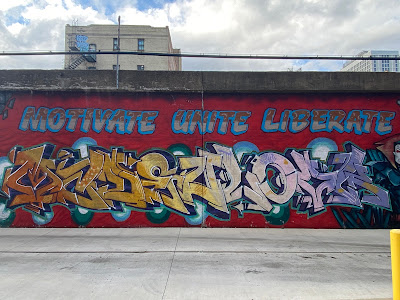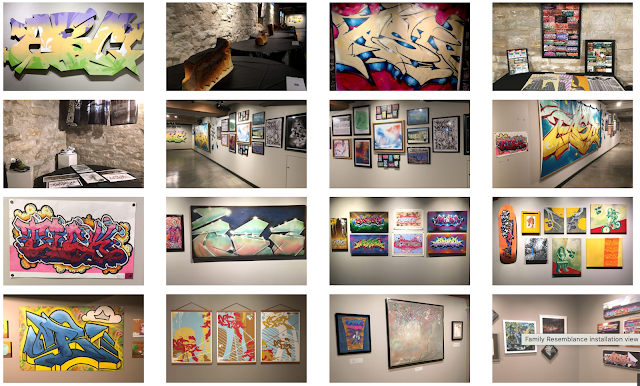Along wall that runs under the El tracks just south of the Devon at Loyola's Lakeshore campus are these Graffiti murals:
What do these murals evoke in you? What do you think when you see them? How do they make you feel? What do you associate them with?
Some people will associate these generally with "urban" America or minorities or crime or vandalism or even street gangs. While these associations may be true in some cases, many may not realize that graffiti is distinctly different from tagging and street art. And as it's own art, graffiti has unique styles, including a Chicago style.
The Newberry Library covered the Chicago style in a presentation with Pengo, East and Dulce Maria Diaz available to watch at the Newberry's Youtube Channel here:
Chicago boasts over 400 murals, according to the city’s Department of Cultural Affairs and Special Events Mural Registry. Though the art form has taken off in recent years — more than four dozen new murals were added to the registry between 2021 and 2022, for instance — Chicago also has an unusually long history of muraling. The “Wall of Respect,” created in Bronzeville in 1967, is thought by many to be the first example of the type of outdoor community mural that is commonplace in American cities today — and, though it no longer stands, several Chicago-area murals from that era still do. John Pitman Weber, a Chicago artist who co-founded the Chicago Public Art Group, told the Chicago Sun-Times that three Humboldt Park murals dating back to 1971 could be the oldest surviving community murals in the country.
One of the three is “The Crucifixion of Don Pedro Albizu Campos,” painted by the Puerto Rican Art Association. It shows figures from Puerto Rico’s Nationalist Party, who advocated for the island’s freedom and revolted in 1950.
Murals like these that represent Chicago’s immigrant populations are a common sight across the city. Mexican muralist Hector Duarte, for instance, has created over 50 pieces of public art in the more than 30 years he has worked in Chicago, and most of his works tell the story of Chicago’s Mexican community. One notable example appears on the side of Duarte’s Pilsen home and studio, where the 3,000-square-foot “Gulliver en el País de las Maravillas” depicts a Mexican immigrant as the titular character from
“Gulliver’s Travels.”Pilsen in general is an important site for immigrant muraling. The neighborhood has been the center of the Mexican American mural movement since 1968, when Mario Castillo painted an anti-Vietnam War mural on the side of the Halsted Urban Progress Center and set off a wave of Chicano street art in the area.
Using art to show solidarity
More recently, artists in Chicago have used murals to express solidarity with places in conflict. Earlier this year, artist Langston Allston unveiled a new mural in Pilsen depicting Palestinians against a war-torn backdrop. The mural, organized by the nonprofit Mural Movement, came as the Israel-Hamas war passed the 100-day mark, and it was meant to show a growing solidarity between Chicago’s Palestinian, Black, and Latino communities.
“A lot of people are like, ‘Oh, it’s none of our business or whatever’ … but who has really shown up for Chicago people?” Mural Movement founder Delilah Martinez told WBBM. “It has been a lot of my Palestinian friends consistently through the years.”
In Ukrainian Village, murals painted since Russia’s full-scale invasion have invoked solidarity and community in the neighborhood. Artist Sean Archer painted a mural on the Ukrainian Village Veterinary Center’s wall in 2022 depicting a young Ukrainian woman with flowers coming out of her palm. Each flower has significance to Ukraine: sunflowers, an “unofficial national symbol” of peace; poppies, a symbol for the remembrance of victims of war; kalyna berries, which have deep roots in Ukrainian folklore; and marigolds, traditionally placed in wreaths to represent fidelity and devotion.
How public art can help business
Wicker Park and Bucktown are home to over 40 murals and public art installations, including “Kintsugi Memories” by Japanese artist Mami Takahashi. That work consists of two blocks of sidewalk along Milwaukee Avenue, whose cracks Takahashi filled with gold epoxy using the traditional method kintsugi, by which broken pottery is repaired with gold.
Alice Howe oversees the Wicker Park Bucktown Special Service Area (SSA), which funds public art projects in the neighborhood using taxpayer dollars from property taxes. The SSA is administered by the Wicker Park Bucktown Chamber of Commerce.
Howe told ChicagoGlobal that the SSA is always looking to represent diverse perspectives and cultures in the neighborhood’s public art. For “Kintsugi Memories,” it was actually Takahashi who approached the SSA.
“So we were really excited to see that,” Howe said. “We have a pretty high foot traffic of tourism, and we want to keep that international element. I think that draws artists specifically to Wicker Park because they will get that exposure, so we just want to continue drawing on that.”
The SSA has multiple ways that public art projects come to fruition. An arts committee made up of local business owners and artists can help brainstorm projects; artists can approach the SSA, as Takahashi did; and business owners can commission artists to paint murals on their businesses’ walls. All of this can help bring foot traffic to the neighborhood and its businesses, Howe said.
“Most recently we just did a collaboration with Heaven Gallery on the back of their building to do a memorial mural that can be seen from the Blue Line station,” she said. “For that one specifically, we were able to do a pretty large ribbon-cutting and an opening ceremony that drew a lot of people to the business.”



































